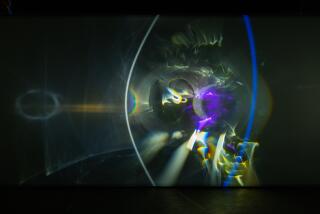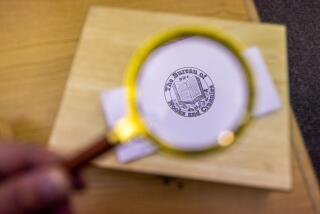Shimmering break from conformity
- Share via
SEATTLE — There is little question that Rem Koolhaas is one of the most influential architects of the last 20 years. As an architectural thinker, his cool analytical approach to design, sprinkled with a healthy skepticism, has informed the profession to such a degree that his fingerprints can be found on the work of almost any young architect today. Koolhaas has achieved the enviable stature of both cult idol and international celebrity -- a designer who is equally comfortable zipping around on private jets as in the halls of academia.
But despite his reputation, followers of the Dutch architect’s career have grown increasingly impatient for a truly great work. His most notable completed structures, such as an exquisite house designed for a quadriplegic in Bordeaux, France, are small, private commissions. Others, such as a 1994 congress hall in Lille, France, are more interesting as works of urban planning than as free-standing buildings. More recent undertakings, such as designing a $40-million Prada shop in Manhattan and guest editing an issue of Wired magazine, have been derided as frivolous. Some began to wonder whether Koolhaas would ever produce a building that lived up to his genius.
The wait is over. Scheduled to open to the public Sunday, the new Seattle Central Library, designed by Koolhaas and his Office for Metropolitan Architecture, is not only a work of immense intellectual power, it is visually stunning. Its contorted cage-like exterior is a powerful commentary on the colliding forces -- economic, political and otherwise -- that shape contemporary society. It is a truly original work.
The library joins a rapidly growing number of remarkable civic structures built in the past decade or so: Daniel Libeskind’s Jewish Museum in Berlin, Toyo Ito’s Mediatheque in Sendai, Japan, and Frank Gehry’s Walt Disney Concert Hall in Los Angeles, to name a few. What all of these projects share is an interest in tearing down the vision of abstract purity that was once a core tenet of modernity.
Of these, Koolhaas’ library is the most strangely hypnotic. Wrapped in a transparent skin of crisscrossing steel beams and diamond-shaped windows, its faceted form has an almost tortured beauty. Surfaces protrude in unexpected ways; seemingly banal forms are imbued with a palpable tension. It is only as the structure’s internal logic begins to slowly emerge that one grasps what is at the core of the project’s beauty: its relentless desire to expose hidden truths.
The library is the centerpiece of a citywide program known as “Libraries for All” that also includes the creation of five new branch libraries and the renovation of nearly two-dozen more. Covering an entire block in downtown, the $165-million central library’s steep hillside site is surrounded by generic corporate towers and apartment buildings. A masonry courthouse faces the building to the east. To the west, the site slopes down toward Elliott Bay five blocks away.
Koolhaas conceived the building as a kind of vertical city. Staff work areas, meeting rooms, book stacks and administrative offices are segregated into distinct zones. As the building rises, these compartments -- which evoke enormous slabs, some four stories deep -- stagger in various directions. A series of public rooms are slotted between them, creating the illusion of alternating layers of solids and voids.
Seen from the street, these forms lurch and pull, as if the building were struggling to break out of its skin. The contortions are not arbitrary; they are a direct response to both its function and its site. Along one side, for example, the structure pulls back from the street to make room for a narrow, sliver-like park required by the city’s zoning ordinances. As one circles to the north, the building’s midsection protrudes to create a dramatic view of the bay from the main reading room.
The design is meant as a challenge to building conventions that have defined architecture for nearly a century. The Modernist argument was that the uniform floor slab was a model of functional efficiency. “Structural honesty” became a catchphrase for repetitive grids of columns. To Koolhaas, such an attitude in not only aesthetically confining; it conceals a lie. It is a miserable vision of conformity, one that smooths over more difficult realities.
Entering from 4th Street, for example, visitors are confronted with a 275-seat public auditorium. The theater’s walls slide back to provide diagonal views to cars and pedestrians passing by outside. At the top of the auditorium, large acoustical panels can be retracted so the audience can peer directly through the building to the courthouse on 5th Street.
To reach that level, visitors shoot up a chartreuse-colored escalator. Koolhaas calls this area the library’s “Living Room.” Essentially a vast atrium lobby, it is conceived at the scale of a public plaza. The taut glass-and-steel skin slants back from the street. At the other end, the room cantilevers out toward 4th Street, as if it were floating. Here, the building’s exterior leans outward, offering vertiginous views down to the street and glimpses between soaring towers to the bay.
The room sparkles like a crystal. But its beauty also contains a subliminal political message. For decades, social commentators have been decrying the corporatization of public space. That process has accelerated in recent years as public anxiety has grown over the threat of terrorist attacks. Security cameras have multiplied; barriers have been built; public areas have been walled off.
By enclosing the lobby inside this protective skin, Koolhaas makes us painfully aware of what is at risk. The courthouse’s luxurious green lawn may be beautiful to look at, but it has been largely off-limits to the public for security reasons. In this context, the structure’s mesh-like exterior conjures a prophylactic barrier, whose function is to protect a fragment of public life from further erosion. It evokes an exotic gilded cage.
That vision of colliding values -- between a fading past and a rapidly advancing future -- is one of the library’s most powerful themes. From the atrium lobby, escalators pierce the concrete form of the meeting room floor to connect directly to what Koolhaas has dubbed the “Mixing Chamber.” This is where real and virtual communities collide. Librarians, with computer chips pinned to their lapels so that they can be quickly located, dispense information. Rows of computers are set up where visitors can browse the Internet or search for books. More views open onto the surrounding skyline and back down to the atrium lobby.
From here, stairs lead back down to the public meeting rooms. A sealed, self-contained world, the slick, curved surfaces of the meeting room walls are painted a rich lipstick red. Koolhaas has used such sexual references before, most notably in the undulating, cave-like entry to his Bordeaux house design. These spaces can look oddly out of place. But they serve as a physical release, an escape from what Koolhaas has referred to as his “hyper-rational” design.
By comparison, the book stacks are enclosed in a four-story slab that hovers above the Mixing Chamber, supported on a grid of steel columns. The stacks are conceived as a continuous, gently ramping spiral. Smooth, diffuse light filters down through translucent panels. The ramp’s slow, methodical climb suggests an almost dreamlike narrative procession, as if Koolhaas were trying to slow the relentless march of time. The slab-like space that houses the ramp, meanwhile, evokes a tomb for books, as if they were mysterious relics from a fading civilization.
Resting on top of this platform is the vast open floor of the main reading room. Light floods this room through the diamond-shaped apertures in the building’s skin. At this point, the entire building lurches over once again, as if stretching its neck to take in a final view of the water between a canyon of skyscrapers. Ferries and barges drift by in the distance, framed by a backdrop of lush mountains. The city itself becomes a place for intellectual exploration.
It is in this regard that the design can be read as the culmination of a lineage stretching back to such projects as Etienne-Louis Boullee’s 1788 proposal for a royal library in Paris. Like Boullee, Koolhaas has designed a monumental temple for knowledge. Light and structure are not only used to animate interior spaces, they symbolize the union of human knowledge and spiritual enlightenment.
The difference lies in Koolhaas’ distrust of absolute truths. In his view, knowledge can act as a disruptive force, one that can be used to shake up static notions about how a society functions.
Koolhaas’ ability to articulate these ideas with such force has made him the intellectual leader in one of the most eclectic and creative periods in recent architectural history. Few architects since Le Corbusier have generated so much theoretical work with such fervor.
As in the case of Le Corbusier, the sweeping range of Koolhaas’ interests has allowed him to penetrate every corner of the profession. Ultimately, however, it is Le Corbusier’s contribution as the creator of some of the 20th century’s greatest buildings that is his most lasting legacy.
With the completion of the Seattle Central Library, Koolhaas now seems poised to become the Le Corbusier of his time, a talent whose architectural triumphs will have as lasting an effect on the arc of architectural history as his theoretical tracts.
Nicolai Ouroussoff is The Times’ architecture critic.
More to Read
The biggest entertainment stories
Get our big stories about Hollywood, film, television, music, arts, culture and more right in your inbox as soon as they publish.
You may occasionally receive promotional content from the Los Angeles Times.










